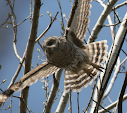
This was a limited intensity birding hike for me. Doing anything on a windy expanse of plains at mid-day is a challenge. Even so, the refuge offers so much to see that even at during admittedly quiet birding hours I still knocked together a 27 species list. The gulls had descended on Lake Ladora, but a contingent were always airborne, riding the gusts and keeping the usually quiet plains fairly noisy.
My effort was rewarded by a few personal first-of-season sightings, including the Horned Lark below.

Against a windswept, grassy, background the horns of a lark can be difficult to pick out. For this bird my ID started in the field and was confirmed before I had zoomed in or cropped this image. Look for the three colors in the tail. The Horned Lark features a tail that has narrow white edges, and a brown central stripe, on otherwise black feathers. It is a good sign, and one that once recognised can be used at highway speeds as these flocks take flight from the roadside.
The Refuge always seems to have a group of Mule Deer somewhere in sight. On this visit I had to make a detour to avoid coming between a lone male and two youngsters who had left the shade of a copse where the rest of the herd was resting. Taking the roads that led the longer way around showed me this deer who did a couple of cuts between mom and the rest of the herd as I tried to remain as far away as possible.

Good thing they carry around their own pair of sun visors!
One positive from strong sunlight is that it can make some markings stand out.

The roufus and white patches on the male Gadwall are much more visible in this light than at dawn or dusk.
Finally, with the least quality is a Franklin's Gull in breeding plumage. This gull is similar in appearance to the Laughing Gull (non-breeding plumage), that I saw in Baltimore last fall. The easiest way to tell these two apart is that the Laughing Gull localizes to the Eastern U.S. seaboard, while the Franklin's Gull migrates north through the plains to Canada in the spring, and back south to Peru in the fall.

Hopefully I get a few more shots to improve the quality this spring.
2010 Count: 97
Lifetime: 210


That refuge has to be a superb place to go for wildlife sighting! I love the pair of ducks on the wing. That's a great shot!
ReplyDeleteOh..you have been doing a bit of hiking too i see..
ReplyDeletesome great birds!
We are hoping to see a Franklins gull here on the coast of TX..
RMANWR is a treat because it is so accessible to the urban core. The cleanup phase is supposed to complete this spring/summer and then a year or two for the new visitor center to be completed.
ReplyDeleteI only wish my hiking could be more consistent, one or two miles on weekdays doesn't seem to keep the soreness down when the mileage gets bumped up on the weekends! Hopefully I will be ready for some real elevation hikes this summer.
Thanks for the comments, good luck on the Franklin's